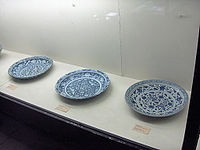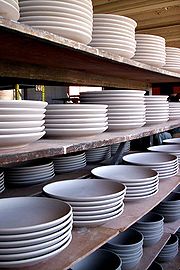
Plate (dishware)
Encyclopedia


Food
Food is any substance consumed to provide nutritional support for the body. It is usually of plant or animal origin, and contains essential nutrients, such as carbohydrates, fats, proteins, vitamins, or minerals...
can be served. A plate can also be used for ceremonial or decorative purposes.
Materials
Plates are commonly made from ceramicCeramic
A ceramic is an inorganic, nonmetallic solid prepared by the action of heat and subsequent cooling. Ceramic materials may have a crystalline or partly crystalline structure, or may be amorphous...
materials such as bone china
Bone china
Bone china is a type of soft-paste porcelain that is composed of bone ash, feldspathic material and kaolin. It has been defined as ware with a translucent body containing a minimum of 30% of phosphate derived from animal bone and calculated calcium phosphate...
, porcelain
Porcelain
Porcelain is a ceramic material made by heating raw materials, generally including clay in the form of kaolin, in a kiln to temperatures between and...
, and stoneware
Stoneware
Stoneware is a vitreous or semi-vitreous ceramic ware with a fine texture. Stoneware is made from clay that is then fired in a kiln, whether by an artisan to make homeware, or in an industrial kiln for mass-produced or specialty products...
, as well as other materials like plastic
Plastic
A plastic material is any of a wide range of synthetic or semi-synthetic organic solids used in the manufacture of industrial products. Plastics are typically polymers of high molecular mass, and may contain other substances to improve performance and/or reduce production costs...
, glass
Glass
Glass is an amorphous solid material. Glasses are typically brittle and optically transparent.The most familiar type of glass, used for centuries in windows and drinking vessels, is soda-lime glass, composed of about 75% silica plus Na2O, CaO, and several minor additives...
, or metal; occasionally, wood
Wood
Wood is a hard, fibrous tissue found in many trees. It has been used for hundreds of thousands of years for both fuel and as a construction material. It is an organic material, a natural composite of cellulose fibers embedded in a matrix of lignin which resists compression...
or carved stone
Rock (geology)
In geology, rock or stone is a naturally occurring solid aggregate of minerals and/or mineraloids.The Earth's outer solid layer, the lithosphere, is made of rock. In general rocks are of three types, namely, igneous, sedimentary, and metamorphic...
is used. Disposable plates are often made from paper pulp, which were invented in 1904. Also melamine resin
Melamine resin
Melamine resin or melamine formaldehyde is a hard, thermosetting plastic material made from melamine and formaldehyde by polymerization. In its butylated form, it is dissolved in n-butanol and xylene. It is then used to cross-link with alkyd, epoxy, acrylic and polyester resins, used in surface...
or tempered glass such as Corelle
Corelle
Corelle is a brand of glassware and dishware. It is made of Vitrelle, a laminated tempered glass product with three layers of two types of glass. The thermally bonded layers give Corelle its strength, allowing it to be much thinner than other dinnerware. Introduced by Corning Glass Works in 1970,...
can be used.
Size
Plates for serving food come in a variety of sizes, from small saucerSaucer
A saucer is a small type of dishware, a plate that is specifically used with and for supporting a cup – a cylindrical cup intended for coffee or a half-sphere teacup for tea. Additionally, the saucer is a distant cousin to the plate. The saucer has a raised centre with a depression sized to fit a...
s, to bread and butter plates, to dinner plates, to large platter
Platter (dishware)
A platter is a large type of dishware used for serving food. It is a tray on which food is displayed and served to people. It can have oval, round, rectangular, or square shape. It can be made of metal, ceramic, or plastic. Plain and ornate platters suitable for more formal settings or occasions...
s from which food for several people may be distributed at table. Some plates are made as decorative items for display rather than used for food.
History
The Chinese discovered the process of making porcelain around 600 AD. It wasn't until 1708 when a German potter in Meissen discovered the Chinese process, that European potteries came into being. Many of the world's best known potteries were founded during this period - Royal Saxon in 1710, WedgwoodWedgwood
Wedgwood, strictly speaking Josiah Wedgwood and Sons, is a pottery firm owned by KPS Capital Partners, a private equity company based in New York City, USA. Wedgwood was founded on May 1, 1759 by Josiah Wedgwood and in 1987 merged with Waterford Crystal to create Waterford Wedgwood, an...
in 1759, Royal Copenhagen
Royal Copenhagen
Royal Copenhagen, officially the Royal Porcelain Factory is a manufacturer of porcelain products and was founded in Copenhagen 1 May 1775 under the protection of Queen Juliane Marie...
in 1775, and Spode, founded in 1776 in England.
Plates as collectibles
When trade routes opened to China in the 14th century, porcelain objects, including dinner plates, became must-haves for European nobility. After Europeans also started making porcelain, monarchs and royalty continued their traditional practice of collecting and displaying porcelain plates, now made locally, but porcelain was still beyond the means of the average citizen.The practice of collecting "souvenir" plates was popularized in the 19th century by Patrick Palmer-Thomas, a Dutch-English nobleman who wowed Victorian audiences with his public plate displays. These featured transfer designs commemorating special events or picturesque locales - mainly in blue and white. It was an inexpensive hobby, and the variety of shapes and designs catered to a wide spectrum of collectors. The first limited edition collector's plate 'Behind the Frozen Window' is credited to the Danish company Bing and Grondahl in 1895. Christmas plates became very popular with many European companies producing them most notably Royal Copenhagen
Royal Copenhagen
Royal Copenhagen, officially the Royal Porcelain Factory is a manufacturer of porcelain products and was founded in Copenhagen 1 May 1775 under the protection of Queen Juliane Marie...
in 1910, and the famous Rosenthal series which began in 1910.

